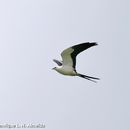en
names in breadcrumbs


Swallow-tailed kites are also known as forked-tailed kites, swallow hawks, wasp hawks, and snake hawks.
Swallow-tailed kites communicate primarily through cries, short, weak, high-pitched whistles, and twitters, usually while hunting or during mating season. They also use visual displays, including postures associated with courtship and mating. Like other raptors, swallow-tailed kites, primarily use vision to hunt for food.
Communication Channels: visual ; acoustic
Perception Channels: visual ; tactile ; acoustic ; chemical
Elanoides forficatus has not been classified as a threatened species. Before 1980, these birds were found as far as the northern Midwest, but due to logging, draining of swamps, and shooting, populations dwindled and are now found only in the southern U.S., mainly in Florida and tropical habitats during the winter. They are protected by the U.S. Migratory Bird Act.
US Migratory Bird Act: protected
US Federal List: no special status
CITES: no special status
State of Michigan List: no special status
IUCN Red List of Threatened Species: least concern
There are no known adverse effects of E. forficatus on humans.
Swallow-tailed kites contribute to control of insect populations in habitats they occupy. They are also lovely birds that attract ecotourism.
Positive Impacts: ecotourism ; controls pest population
There is little known about the role of wallow-tailed kites in their native ecosystem, although it can be surmised that they help control insect populations.
Swallow-tailed kites are primarily insectivorous, snatching and feeding on flying insects in mid-air, but they are also known to capture other prey, such as snakes, frogs, and nestlings and fledglings. They do not hover and usually eat prey in mid-flight. They also drink in flight in a fashion similar to swallows, by skimming the water.
Animal Foods: birds; amphibians; reptiles; insects
Primary Diet: carnivore (Eats terrestrial vertebrates, Insectivore )
Elanoides forficatus, otherwise known as the American swallow-tailed kite, is found primarily in the southeastern United States, from Louisiana to South Carolina. Most of the known population is centered in the southern tip of Florida. In the winter E. forficatus migrates to South America.
Biogeographic Regions: nearctic (Native ); neotropical (Native )
Swallow-tailed kites occupy wooded swamps, open forests, lake shores, and freshwater marshes. They nest near sources of water in tall trees, anywhere from 18 to 40 meters above the ground.
Range elevation: 0 (low) m.
Habitat Regions: temperate ; tropical ; terrestrial
Terrestrial Biomes: forest
Aquatic Biomes: coastal
Wetlands: marsh ; swamp
Other Habitat Features: riparian
There is no specific information available on the lifespan of E. forficatus, but the lifespan of one white-tailed kite was recorded to be nearly 6 years.
The most notable feature of E. forficatus is the deeply forked swallow-like tail, which distinguishes this kite species from its relatives, Mississippi kites and white-tailed kites. The structure of the tail enables this kite to fly well at low speeds. The wings are long and thin, enabling flight at high speeds as well.
Swallow-tailed kites are monomorphic. Adults have black wings with white undersides, white heads, necks, and underparts. The tail and upperparts are iridescent black, with streaks of green, purple, and bronze. Juveniles look similar to adults but with slightly streaked heads and underparts, as well as shorter white-tipped tails.
Swallow-tailed kites have a body length ranging from 49 to 65 cm. Wingspan is from 114 to 127 cm. The average weight of maled is 441 g and the average weight of females is 423 g, although females may be slightly larger in size.
Range mass: 423 to 441 g.
Range length: 49 to 65 cm.
Average length: 58 cm.
Range wingspan: 114 to 127 cm.
Average wingspan: 122 cm.
Other Physical Features: endothermic ; homoiothermic; bilateral symmetry
Sexual Dimorphism: sexes alike; female larger
Little is known about predators of swallow-tailed kites, but fledglings are often preyed on by owls, especially great horned owls (Bubo virginianus).
Known Predators:
Swallow-tailed kites are monogamous, although pair bonds are not necessarily maintained between breeding seasons. Females and males will approach each other on a horizontal tree limb. The female will quickly go under the limb or turn, bending forward with the wings extended. The male lands on her back and drapes his wings over the female, then mating occurs. There is also courtship feeding.
Mating System: monogamous
Swallow-tailed kites breed once per year, usually in April. They produce loud shrills, squealing calls, and whistles during the mating season. Females usually lay two eggs per clutch. The eggs are incubated for approximately 28 days, and the fledgling period lasts anywhere from 36 to 42 days. Fledglings can take an additional 2 weeks or more to become independent.
Breeding interval: Swallow-tailed kites breed once yearly.
Breeding season: The breeding season is short and usually occurs in the month of April.
Range eggs per season: 3 (high) .
Average eggs per season: 2.
Average time to hatching: 28 days.
Range fledging age: 36 to 42 days.
Range time to independence: 50 (low) days.
Key Reproductive Features: iteroparous ; seasonal breeding ; gonochoric/gonochoristic/dioecious (sexes separate); sexual ; oviparous
Not much is known about the degree of parental investment in swallow-tailed kites. Both parents incubate the eggs. When one parent comes in to sit on the eggs, the other flies straight up from the nest. The incoming parent hovers over the nest, and then gently settles down. Young are altricial. In their close relatives males bring back food while females watch the young and protect the nest. Towards the end of the nesting period both parents will hunt. After fledging the adults continue to provide food for their young.
Parental Investment: altricial ; pre-fertilization (Provisioning, Protecting: Female); pre-hatching/birth (Provisioning: Female, Protecting: Male, Female); pre-weaning/fledging (Provisioning: Male, Female, Protecting: Male, Female); pre-independence (Provisioning: Male, Female)